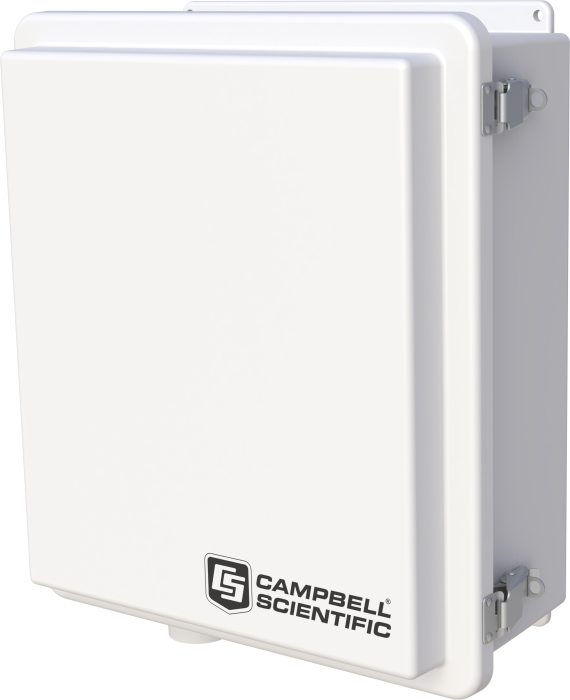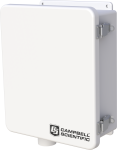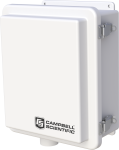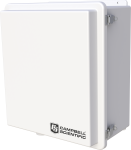
Campbell components mount easily and securely






Overview
The ENC14/16 is a weather-resistant enclosure that is 14 in. wide and 16 in. tall. This medium-large enclosure can house a datalogger, a power supply, and one or more peripheral—depending on the size of the peripherals. A common use for the ENC14/16 is to mount a larger enclosure to the leg base of a CM110, CM115, or CM120 tripod, because the larger ENC16/18 cannot be mounted to the leg base of these tripods.
Read MoreBenefits and Features
- Weather resistant to protect instruments
- Backplate designed so that Campbell Scientific components mount easily and securely
- White, UV-stabilized enclosure reflects solar radiation—reducing temperature gradients inside the enclosure without requiring a separate radiation shield
Images

3D/CAD Files:
Technical Description
The ENC14/16's backplate is prepunched with half-inch-on-center holes suitable for attaching a data logger, power supply, and a communications or measurement and control peripheral.
This enclosure is shipped with the 7363 enclosure supply kit that consists of desiccant, a humidity indicator card, cable ties, wire tie tabs, putty, grommets, screws, and PVC coupling. Additionally, Campbell Scientific offers a CS210 Enclosure Humidity Sensor for monitoring relative humidity inside of the enclosure. (See Ordering Info on the web page.)
Compatibility
Please note: The following shows notable compatibility information. It is not a comprehensive list of all compatible products.
Dataloggers
| Product | Compatible | Note |
|---|---|---|
| 21X (retired) | ||
| CR10 (retired) | ||
| CR1000 (retired) | ||
| CR10X (retired) | ||
| CR200X (retired) | ||
| CR211X (retired) | ||
| CR216X (retired) | ||
| CR23X (retired) | ||
| CR300 (retired) | ||
| CR3000 (retired) | ||
| CR350 | ||
| CR500 (retired) | ||
| CR5000 (retired) | ||
| CR510 (retired) | ||
| CR6 | ||
| CR800 (retired) | ||
| CR800 (retired) | ||
| CR850 (retired) | ||
| CR850 (retired) | ||
| CR850 (retired) | ||
| CR850 (retired) | ||
| CR9000 (retired) | ||
| CR9000X (retired) |
Specifications
| Color | White (Reflects solar radiation, reducing temperature gradients inside the enclosure without requiring a separate radiation shield.) |
| Construction | Fiberglass-reinforced polyester enclosure with door gasket, external grounding lug, stainless-steel hinge, and lockable hasps |
| Enclosure Classification | NEMA 4X (before being modified for cable entry) |
| Number of Cable-Entry Seals | 2 large, 2 medium, 2 small |
| Dimensions |
|
| Weight | 6 kg (13 lb) |
Related Documents
Related FAQs
Number of FAQs related to ENC14/16: 13
Expand AllCollapse All
-
The ENC14/16 weighs 13 lb. Its internal dimensions are 14 x 16 x 5.5 in.
-
Is a fiberglass enclosure suitable for an installation in a very cold location monitoring corrosion?Our fiberglass enclosures can withstand very cold locations, and their fiberglass/plastic construction is very resistant to corrosion.
-
Use a router with a fine-toothed bit. A hole saw will also work, but the edges will not be as clean as from using a router.
-
The terminals do not need to be replaced. Just sand or file the corrosion away, exposing clean copper, and the fittings will continue to be functional.
-
Yes. Each enclosure Campbell Scientific sells has a powder-coated backplate with holes on 1 in. centers that match the mounting flanges on our equipment for easy mounting.
-
It depends on the device. Most devices have built-in mounting flanges, but some items require a separate mounting bracket.
-
Backplates are available in sizes designed to fit in Campbell Scientific enclosures: 10 x 12 in., 12 x 14 in., 14 x 16 in., and 16 x 18 in.
-
The following information is applicable to many of Campbell Scientific’s standard enclosures and prewired enclosures.
Note: The procedure below will not work for torn or damaged seals.
To make a field repair to a loose gasket on an enclosure, first acquire an adhesive, such as standard Gorilla Glue, that is rated for use with polyurethane foam. The adhesive should be compatible with, and recommended for, use with polyurethane foam. Follow these steps:
- Pull the gasket away from the gasket channel, being careful not to tear the gasket. The gasket does not need to be removed completely. Rather, remove only those areas that have pulled loose on their own. To keep the gasket up out of the way, lay a small object (such as a toothpick, pen, or pencil) horizontally across the channel.
- Using an adhesive that is rated for use with polyurethane foam, apply a small bead of adhesive to the gasket channel. Because the adhesive’s only function is to keep the gasket in place, use it sparingly.
- Remove any objects that were holding the gasket out of the way.
- Carefully place the gasket in the gasket channel.
- Wait 1 to 3 hours for the adhesive to cure before closing the door.
Case Studies
The Solar Decathlon takes place every other year on the National Mall in Washington, D.C.......read more





